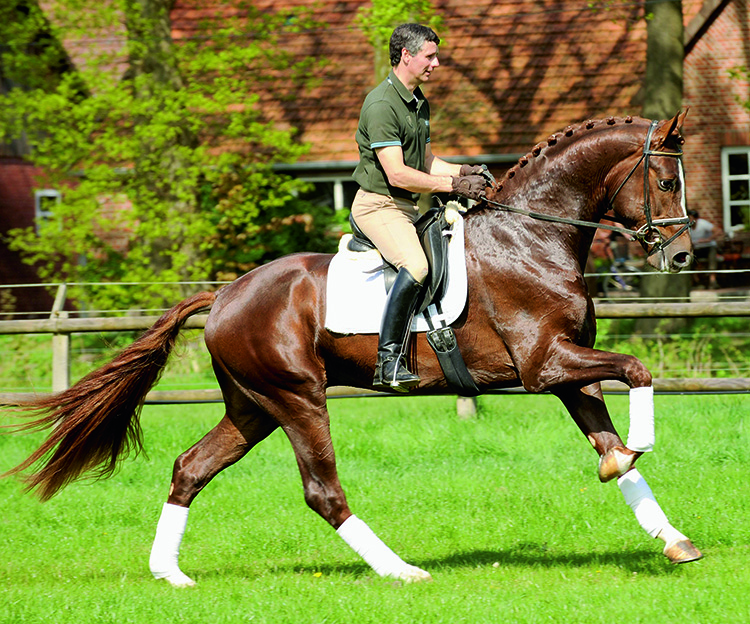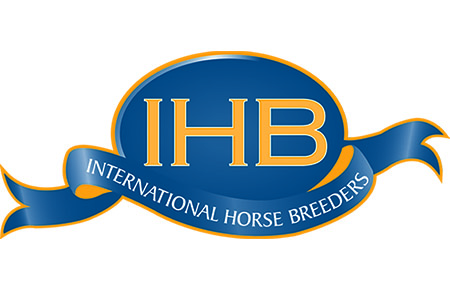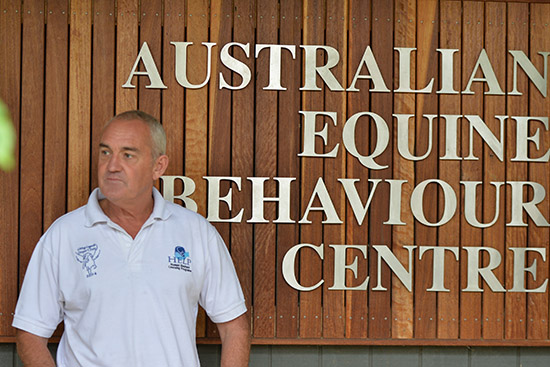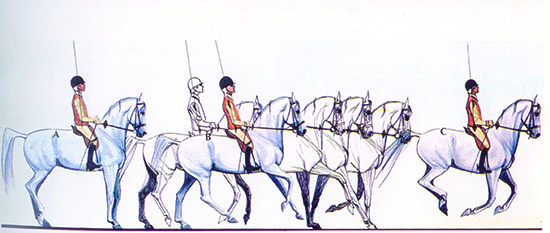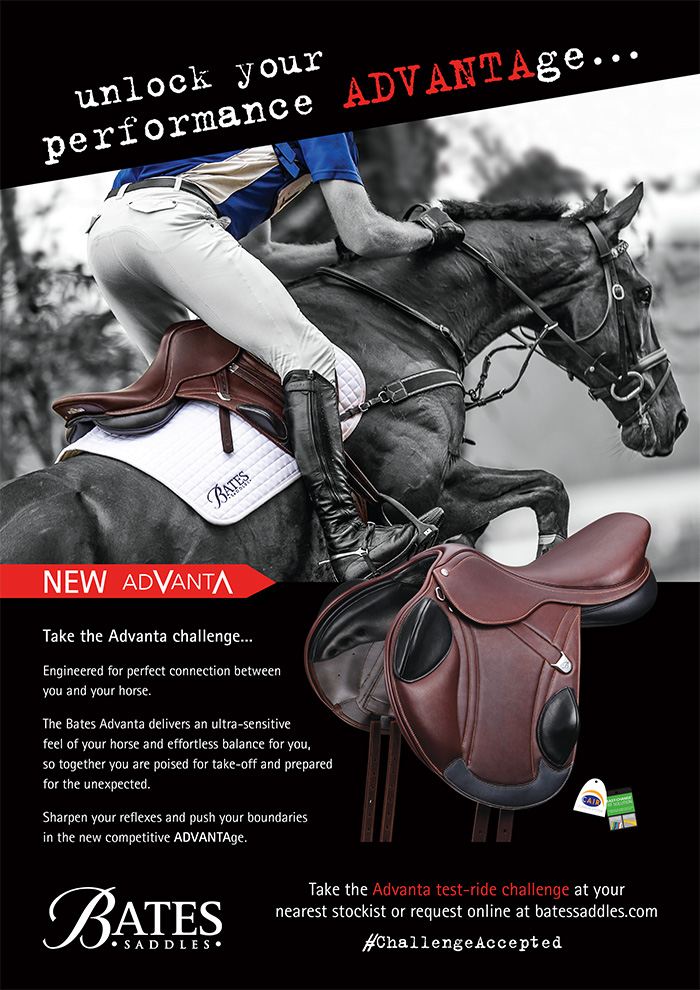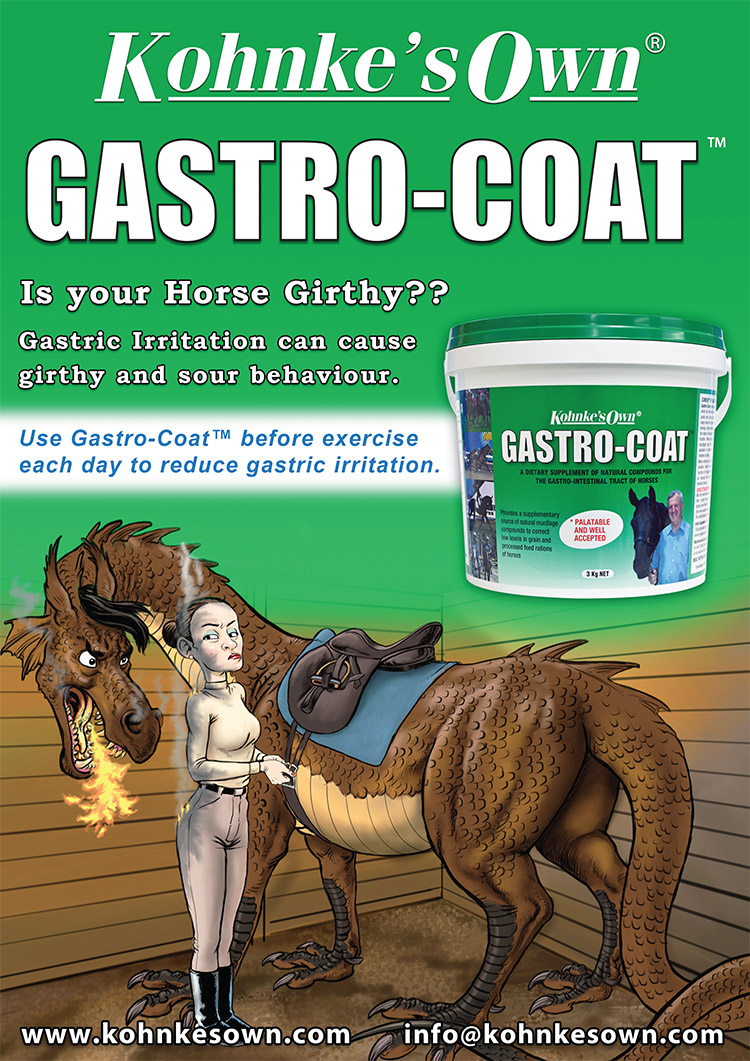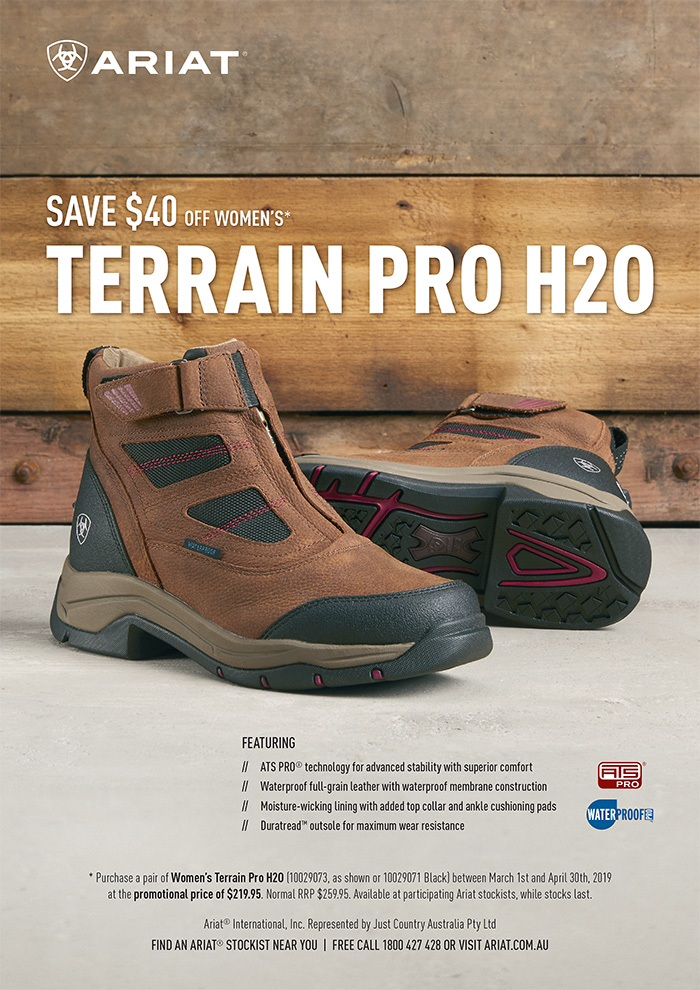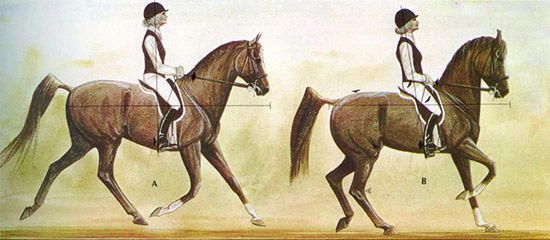A conversation with Chris Hector
Andrew McLean’s role is changing, his son, Alistair, has returned from Denmark, and is taking over many of the day-to-day responsibilities at the Australian Equine Behaviour Centre, leaving Andrew free to respond to the many requests to speak and teach…
“I’m teaching in so many places, 14 different countries now including my work with elephants. I’m hardly at home at all this year. In many respects word is spreading; I have quite a bit to do with various people around the world in all aspects of horse sports.”
And as usual with Andrew, there is something new ticking over in his head…
“My latest work and interest is in teaching people about the relationship between learning theory and biomechanics. I have a PhD student, Lesley Hawson, who is just completing this year and she has done some very interesting work with looking at the relationship between rein, leg and seat pressures and biomechanics. I’ve learned a lot through her investigations.”
“When it comes to learning about animal training principles, horse people get short-changed. Federations and coaching systems just don’t teach it. My role is to do that and therefore teach people to recognise there are two levels of training. The first level is the training of the operant basics of stop, go, turn forelegs and turn hindlegs. This level establishes the boundaries and precision of the required behaviours. This is no simple matter because all of these ‘buttons’ require not just all-or-nothing reactions but proportional aid/ response associations. i.e. a tiny leg aid means a little more tempo while a stronger leg aid may mean greater acceleration plus all the ranges in between. Ideally these reactions should be established before focusing on the seat and position as aids. Instead the rider position should be perfectly balanced and totally unobtrusive.”
“The rider’s seat should ‘ride the wave’, but not deliberately influence it just yet. If the rider begins focusing on using the seat as an aid too early it can be to the detriment of the acquisition of lightness of rein and leg responses as well as rein and leg proportions, and this misunderstanding of pressure can make the horse insecure. These are known as dysfunctions in negative reinforcement and account for the largest amount of behaviour problems. Therefore, with a balanced rider, when the horse has learned the ranges of go (including up gait, up tempo and longer strides) and the ranges of stop/slow (including down gait, down tempo and shorter strides) as well as turn the forelegs and turn the hindlegs, all from light aids, then the horse is ready for next level. This is about spelling things out to the horse, one at a time.”
“The second level, the classical conditioning phase, involves recognising the influence and the more subtle aspects of the rider’s body, so that they may also become cues for the horse to perform his basics. The important thing is consistency. For example the rider might close the thighs for downward transitions at the onset of the light rein aid. The rider may accentuate the seat or weight aid for a particular response. I am generalising because different trainers have different seat aids and I don’t think it matters providing a) you are consistent and b) you use a seat aid that is consistent with the existing biomechanics. Separating these two levels, the operant and classical conditioning phases, isn’t just for the horse, it teaches the rider to be precise about how the legs and reins are used as well as teaching the horse the aids and responses.”
“People sometimes think that I don’t value the seat influence, but that is untrue. I just see that it has its place. What I am insistent on though is that the rider gets all of the pressure-release aids shrunken to very light aids before focusing on the seat. I say that because I see so many problem horses that know something of the seat, but know little of the rein or leg pressures and this is highly disturbing for the horses, especially when rein contact is focused on instead of its original purpose – slowing. Also, teaching all things at one time is messy, not good teaching and forces people to do the impossible – and that is multitask learning. Horses that respond to seat but not to rein aids can be dangerous in stress situations and account for many injuries. Because when stress is high, seat aids, voice aids and mere associations are less noticed (adrenaline has an analgesic effect). Horses are only safe if they know pressure-release clearly and I say that with urgency. 25% of all children’s sport related hospital admissions are from horse riding, and not teaching them how to use pressure release in horse training is not only bad for horse welfare but deadly dangerous for children (or any pupil).”
“To me, recognising the importance of the operant aids is so critical. These are the basics. We must recognise the primacy of the reins and legs, especially the reins because these are overlooked nowadays and people are commonly only taught that the rein is ‘contact’. The reins not only decelerate but they also shorten the stride. We don’t always see it because in a well-trained horse it is invisible. But it is there, proven by rein tensiometry studies, and it should be kept polished. Riders tend to notice only that they use their seat because in a well-educated horse, the seat influence will be far more obvious. However there is always a rein spike; so keeping these responses polished makes sense. Furthermore we need to ensure the horse can differentiate between the aids for alterations in gait, tempo and stride length so riders should think about this from the horse’s point of view. The rein is also the most basic turning mechanism. Gallop toward a cliff and see what aids you will choose or watch an event rider as his horse veers from a skinny fence. Stop, go, and turn are the real basics. We should move away from the more recent German view that the basics are rhythm & relaxation. Rhythm and relaxation are essential qualities of the basics, but not basics themselves. If we recognise that the basics are about getting the horse’s locomotion operating from light aids, then we have to understand all those things that reins and legs do.”
much more follows
“To recognise priorities in training, that is a big step forward. Now I am looking at the next step and that is recognising that we are rewarding, in all our basics, various muscles pulling on bones: we are manipulating the biomechanics of the horse, yet horses tend to have uneven locomotion.”
“It’s an endlessly fascinating area of study. Another thing I find very interesting is that the horse defaults to sideways hindleg movements when he’s tense. If he moves his hind legs sideways one way when he’s tense, his forelegs are pushing the other way. That is where the trouble started. As I started to delve into this, particularly through my work in biomechanics, both with Lesley Hawson and also with writing the book Equitation Science, I found that what is crucial is this big cluster of nerves in the horse’s spinal cord called the central pattern generator. It’s actually a ‘neural oscillator’ (like a light switch with multiple settings) and what it basically does, it arranges the synchrony of the legs, the gaits, and the diagonal couplets. What the central pattern generator tells us is that the information tends to flow from front to back. The forelegs tell the back legs what to do. That makes a difference in our understanding, when hind legs make sideways mistakes, you correct the front legs.”
“It made sense to me then, when I saw Kyra Kyrklund teaching, where she says, ‘if the horse’s hind legs are to one side, don’t put the hind legs back in place, put the forehand in front of the engine.’ It is a more lasting way of fixing a problem with crookedness, because it is really the forelegs that have made the mistake. You see hind legs making bigger mistakes, because the hind leg has the capacity to really spin out, but they always manifest as very small mistakes in the forelegs. So if the hindlegs are to the left, the forelegs are to the right, even if it is only a tiny amount and barely visible. Just finding that small mistake in the forelegs gets the horse back on track.”
“Once you start looking at horses moving in different gaits, tempos and stride lengths, you begin to see natural asymmetries in horses. All vertebrates are lateralised and understanding how this effects movement is very illuminating. Firstly we know as a general principle that horses’ legs work in diagonal couplets. This is true in all gaits but of course the diagonal couplets may be a little separated in gaits like walk and canter.”
more follows
“When one diagonal couplet is in swing (air) phase, the other is in stance (ground contact) phase. The speed and stride length of the swing phase is equal to that of the stance phase. The power of course is in the stance phase. So if the swing is rushing through the air so too the other diagonal couplet in stance phase is accelerating.”
“What is very interesting is that the two diagonal couplets have different characteristics. One couplet tends to be a ‘running’ pair whilst the other is a ‘stalling’ pair. In other words, one pair resists the rein aids and typically the other one resists go aids. Commonly it is the right fore/left hind that resists slowing. This is mostly why horses are heavy on the right rein (it’s not all due to rider’s holding the rein stronger). This insight is really crucial. When shortening, slowing, in lateral work or in rein-back you will see these differences and so in early training it is a good thing to train the horse to be more ambidextrous. The rider can either slow the running foreleg with the same side rein during the swing phase or accelerate the hindleg of the stalling couplet.”
“We see many horses in dressage lopsided in lateral work; we see it in changes, where one change is bigger than the other. We see it in lateral work and in collecting work. Once we identify which of our horse’s diagonals plays the dominant role in the process, then we can start making the horse even on both diagonals.”
“The slightly complex aspect to all of this is horses, or animals generally, have this complex wiring that means not only are the diagonal couplets connected (what you do to the right foreleg you also do to the left hind) but you simultaneously affect the contralateral legs in stance phase too: as you slow the legs in swing phase, you correspondingly reduce the ground power of the stance phase legs. This is true not only for slowing but also for shortening. If you reduce the size of the swing phase leg, you will be shortening the stance phase leg. What you do will affect the other, but you work by opposite. This knowledge is not part of conventional equestrian wisdom but has enormous potential to even up your horse’s locomotion. How many Grand Prix horses have uneven piaffe?”
“To use this insight, we have to understand exactly when our aids can influence the horse. A rein or leg aid is effective only when the same side fore or hindleg is in a swing phase, but not in the stance phase. When a leg is in the stance phase it is actually locked away by its proprioceptive focus, whereas the swing phase is basically open to the rider to do whatever we want. The right rein therefore works during the swing phase of the right front leg, the rider’s right leg works during the swing phase of the right hind leg, and so on. We can influence these pairs.”
Sounds fascinating, but just how is it going to help the rider in practical terms?
“You see these differences commonly in horse training, this is why good dressage trainers talk so much about the importance of straightness – the difference is, by understanding biomechanics, we have a much better chance of making the horse truly straight, because much of it is due to bilateral asymmetry.”
“So if we want a square halt but the horse’s hindquarters swing to the right in the transition, just a little bit more vibrating pressure on the right rein during the swing of the right foreleg will actually help make the halt square because it reduces the greater stance phase power of the left hind that overdoes the ground power, pushing the hindquarters to the right.”
“One exercise that I do with my riders is that I get them to halt from the walk a few times. After a number of repetitions you will see that there is always one foreleg that typically halts ahead of the other. That’s the running leg. Let’s say it’s the right foreleg. To train squareness in halt we are going to target that leg to be the last foreleg to stop when we halt. How do we do that? Well if the horse is anything close to halting squar-ish, you will find that the last foreleg to halt will be the first one to step forward when you say go. So if the horse finished on the right foreleg, you can ensure the right will be last if you do an odd number of steps. If the last foreleg to stop is the left foreleg, and you want to target the right then do an even number of steps. So if you give a little bit of a vibration each final step of the right front leg, so that the right front leg comes beside the left, then the horse gets lighter and lighter. Most riders, even skilled ones, have difficulty choosing a particular foreleg to finish on in the first few repetitions.”
“I’ve done a bit of work with my son, Warwick, in Dusseldorf, where he had a really flash moving horse. It was flash but very uneven, so we nudge the swing phase of the leg that was going too small in swing phase (to power up the opposing stance phase leg). The precision is important because you have to leave the other legs in swing phase alone. I did a similar thing when I did some work with the British rider, Wayne Channon and his horse Lorenzo a few years ago. He was uneven in the half-pass so I decided which swing phase (in the opening or closing foreleg phase) was collapsing and tapped the shoulder in that swing phase. It was the closing foreleg that collapsed.”
You can breed to Floriscount for the 2019 season, and many other great European stallions, see the complete selection available from International Horse Breeders: www.ihb.com.au
